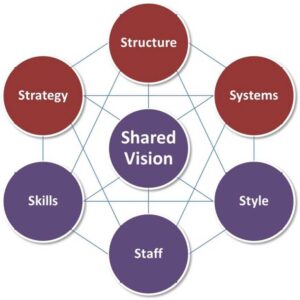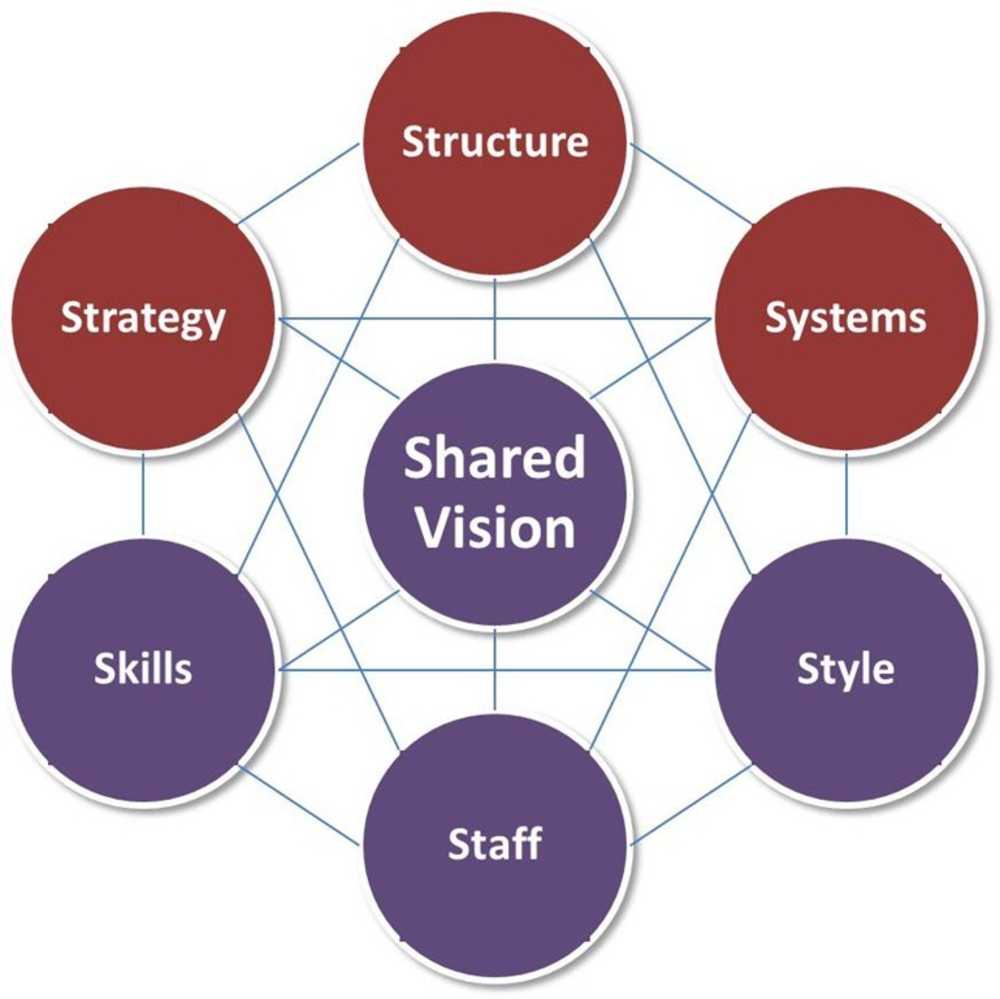Ensuring your team operates as a harmonious unit is a key to project success, particularly if you are managing a diverse virtual team. The McKinsey 7-S Framework is one useful approach to understanding how the team is interacting.
The McKinsey 7-S framework was developed in the early 1980s by Tom Peters and Robert Waterman, two consultants working at the McKinsey & Company consulting firm. The basic premise of the model is that there are seven internal aspects of an organization that need to be aligned if it is to be successful. Whilst the 7-S framework was originally focused on large organisations, the concepts are equally valid for small organisations such as your project team!
The Seven ‘S’ Framework

The framework involves three ‘hard’ elements and four ‘soft’ elements. The ‘hard’ elements are easier to define and management can directly influence them; the team structure, its strategy, and the systems used by the team for work and communication.
The ‘soft’ elements are probably more important, but are also more difficult to define measure and document and are influenced by personalities and culture. When you have a team made up of the ‘right people’ (staff), with the ‘right skills’, working in the ‘right way’ (style) to achieve a shared vision, deficiencies in strategy, structure and systems can be mitigated, but when all seven elements are aligned and effective each one works to increase the power of the other elements. A fully aligned framework has enormous power to generate project success.
The elements involve:
- Strategy: the agreed approach to accomplishing the project’s objectives[1].
- Structure: the way the project team is organised and who reports to whom.
- Systems: the tools, techniques and processes used by the team to accomplish the strategy.
- Shared Values: the core values of the team that are evidenced in its culture and general work ethic[2].
- Style: the behaviour patterns of the team, their ways of interacting, and approaches to leadership and authority.
- Staff: the makeup of the team – ‘having the right people on the bus[3]’.
- Skills: the actual skills and competencies of the team members.
Shared Values is placed in the middle of the model to emphases that the ‘team’s values’ are central to achieving the optimum outcomes from all of all the other elements. As these values change, so will all the other elements.
Understanding the project’s strategy shapes the other ‘hard’ elements – the systems and structures used by the team need to support the implementation of the strategy, not work against it. The optimum structures and systems used in an ‘Agile project’ will be quite different to those used in a more traditional project; the systems needed to support a virtual team will be very different to those needed for a co-located team.
Then we come to the actual team members (staff and their skills); getting the right people with the necessary skills who are willing to work together using the team’s systems to accomplish the strategic objectives of the project is always difficult. Where possible, look at the project through the McKinsey 7-S lens and select people who are suited to the role being filled. If this is not possible look at the people you have through the McKinsey 7-S lens and adjust the structure and systems to give them the best chance of being successful.
The two elements the project manager has the most influence over are style and shared values. These are set at the beginning and people joining the team tend to adopt the ‘teams values’ based on the style of the people already there. Changing these is difficult and requires sustained effort – if you start right the tendency will be to perpetuate the ‘good behaviours’ as the team grows.
However, if you need to change these we suggest you work through the following steps:
- Start with your Shared Values: Are they consistent with your structure, strategy, and systems? If not, what needs to change and how can the change be implemented?
- Then look at the hard elements. How well does each one support the others? Identify where changes need to be made. The project’s objectives don’t change but everything else can be adapted (including the strategic approach) to maximise the chances of a successful delivery.
- Next look at the other soft elements. Do they support the desired ‘shared values’? Do they support the desired hard elements? Do they support one another? If not, what needs to change?
As you adjust and align the elements, you’ll need to use an iterative approach of making adjustments, and then re-analysing how the change that impacts other elements and their alignment.
Some questions to help focus on the 7-S elements
Here are some of the questions that you’ll need to explore to help you understand your situation in terms of the 7-S framework. Use them to analyse your current situation first, and then repeat the exercise hypothetically to describe your proposed situation.
Strategy:
- What is our strategy?
- How do we intend to achieve our objectives?
- How are changes in customer demands dealt with?
- How is strategy adjusted for environmental issues?
Structure:
- How is the team divided/organised?
- What is the hierarchy?
- How do the various sections/people coordinate activities?
- How do the team members organise and align themselves?
- Is decision-making and controlling centralised or decentralised? Is this as it should be, given what we’re doing?
- Where are the lines of communication? Explicit and implicit?
Systems:
- What are the main tools and processes used by the team? Consider financial, HR communication and document storage. Look at both the ‘hardware’ and the ‘soft systems’.
- Where are the controls and how are they monitored and evaluated?
- What internal rules and processes does the team use to keep on track?
Shared Values:
- What are the core values?
- What is the team culture, does this fit with the wider corporate culture?
- How strong are the values?
- What are the fundamental values that the company and team are built on?
Style:
- How participative is the management/leadership style?
- How effective is that leadership?
- Do employees/team members tend to be competitive or cooperative?
- Is this a real team or just a nominal group?
Staff:
- What positions or specialisations are represented within the team?
- What positions need to be filled?
- Are there gaps in required competencies?
Skills:
- What are the strongest skills represented within the company/team?
- Are there any skills gaps?
- What is the team known for doing well?
- Do the current team members have the ability to do the job?
- How are skills monitored and assessed?
All of this may sound like hard work, but the end result of better performance will be worth it.
_______________
[1] For more on project strategy see: http://www.mosaicprojects.com.au/WhitePapers/WP1038_Strategy.pdf
[2] For more on ethics see: http://www.mosaicprojects.com.au/WhitePapers/WP1001_Ethics.pdf
[3] From: Good to Great by Jim Collins; see:
https://mosaicprojects.wordpress.com/2016/01/06/how-to-succeed-as-a-pm-in-2016/

